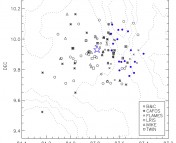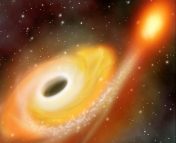Title: Prompt Accretion Disk Formation in an X-Ray Faint Tidal Disruption Event
Authors: Tiara Hung, Ryan Foley, Enrico Ramirez-Ruiz, Jane L. Dai, Katie Auchettl, Charles D. Kilpatrick, Brenna Mockler, Jon Brown, David A. Coulter, Georgios Dimitriadis, Tom Holoien, Jamie Law-Smith, Anthony L. Piro, Armin Rest, Cesar Rojas-Bravo, Matthew R. Siebert
First author’s institution: Department of Astronomy and Astrophysics, University of California, Santa Cruz
Journal: Submitted to the Astrophysical Journal. Open access on ArXiv.
To Catch an Accretion Disk
The Universe reveals an amalgam of ways in which stars can die. We observe stars imploding, erupting and merging, yet the tidal disruption event (TDE) is one of the most tumultuous spectacles of stellar destruction we have discovered so far. This transient phenomenon begins with a star orbiting near a supermassive black hole (SMBH) in the galaxy center. Oblivious of its impending doom, the star’s trajectory pushes it too close to the SMBH’s sphere of gravitational influence and tidal forces begin to shred the stellar structure. The woeful star is now a fly in a supermassive spider’s web: the star will be ripped apart, spaghettified stellar gas coming to form an accretion disk. This then results in a violent eruption of radiation as bits of star fall into the central black hole (Figure 1).
While we discover hundreds of TDEs every year, the nature of how the star is disrupted and comes to form an accretion disk around a SMBH is still very much an open question. Theoretical predictions spanning the past two decades suggest that this infall of gas from the disrupted star can, however, be uniquely recognized in spectroscopic observations. For example, as shown in Figure 1 (A), a smoking-gun signature of the accretion of stellar material is a double-peaked H-alpha emission line that arises from excited Hydrogen being consumed by the SMBH. And now this exact process was observed!
Theoretical Predictions Confirmed
In an exciting leap for the study of TDEs, the authors of today’s paper present the first confident detection of a newly formed accretion disk around a SMBH. The discovered explosion is a TDE called Astronomical Transient (AT) 2018hyz, which was observed spectroscopically by the team for over 300 days after the explosion was detected. In Figure 2 we see that by Day 51 the SMBH’s stellar consumption has revealed itself in the form of “horned” Hydrogen emission line profiles.
This exquisite display of accretion around a SMBH allowed the author’s to precisely model the TDE’s physical parameters such as the velocity, orientation, inclination and eccentricity of the stellar gas being accreted. By running a 10 parameter grid search, the author’s fit the peaked H-alpha emission in AT 2018hyz’s spectra with a multi-component model shown in Figure 3. Specifically, their modeling revealed that TDE 2018hyz was observed at a large enough inclination angle to allow for the detection of this double-peaked line profile, a direct signature of a visible accretion disk. The confirmation that TDE spectra are influenced by the angle at which we view the accretion disk will be extremely applicable to future TDE observations. This discovery has demonstrated that any TDE without double-peaked features was most likely observed with only the edge of the accretion disk visible to us.
The most exciting thing about confidently detecting an accretion disk is that it is now possible to distinguish between individual components of the TDE as a whole. For example, an accretion disk model cannot completely fit the H-alpha profile in Figure 3. The author’s show that you also need a Gaussian line profile that physically represents a turbulent outflow of gas following the disruption of the star. While subtle, this newfound ability to separate the pieces of star plummeting into a SMBH from the gas that is violently ejected outwards will be instrumental in painting an accurate picture of how these brilliant bursts of radiation occur.
It should be noted that other teams have published journal articles on this same TDE e.g., Short et al. 2020, Gomez et al. 2020




